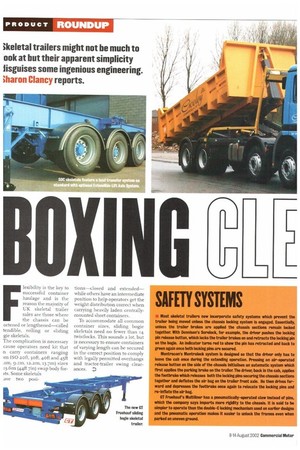„SAFETY SYSTEMS
Page 28

If you've noticed an error in this article please click here to report it so we can fix it.
• Most skeletal trailers now incorporate safety systems which prevent the trailer being moved unless the chassis locking system is engaged. Essentially, unless the trailer brakes are applied the chassis sections remain locked together. With Dennison's Surelock, for example, the driver pushes the locking pin release button, which locks the trailer brakes on and retracts the locking pin an the bogie. An indicator turns red to show the pin has retracted and back to green again once both locking pins are secured.
Montracon's Montralock system is designed so that the driver only has to leave the cab once during the extending operation. Pressing an air-operated release button on the side of the chassis initialises an automatic system which first applies the parking brake on the trailer. The driver, back in the cab, applies the footbrake which releases both the locking pins securing the chassis sections together and deflates the air bag on the trailer front axle. He then drives forward and depresses the footbrake once again to relocate the locking pins and re-inflate the air bag.
CT Fruehauf's Multiliner has a pneumatically-operated claw instead of pins, which the company says imparts more rigidity to the chassis. It is said to be simpler to operate than the double-C locking mechanism used on earlier designs and the pneumatic operation makes it easier to unlock the frames even when parked on uneven ground.
















































































































































